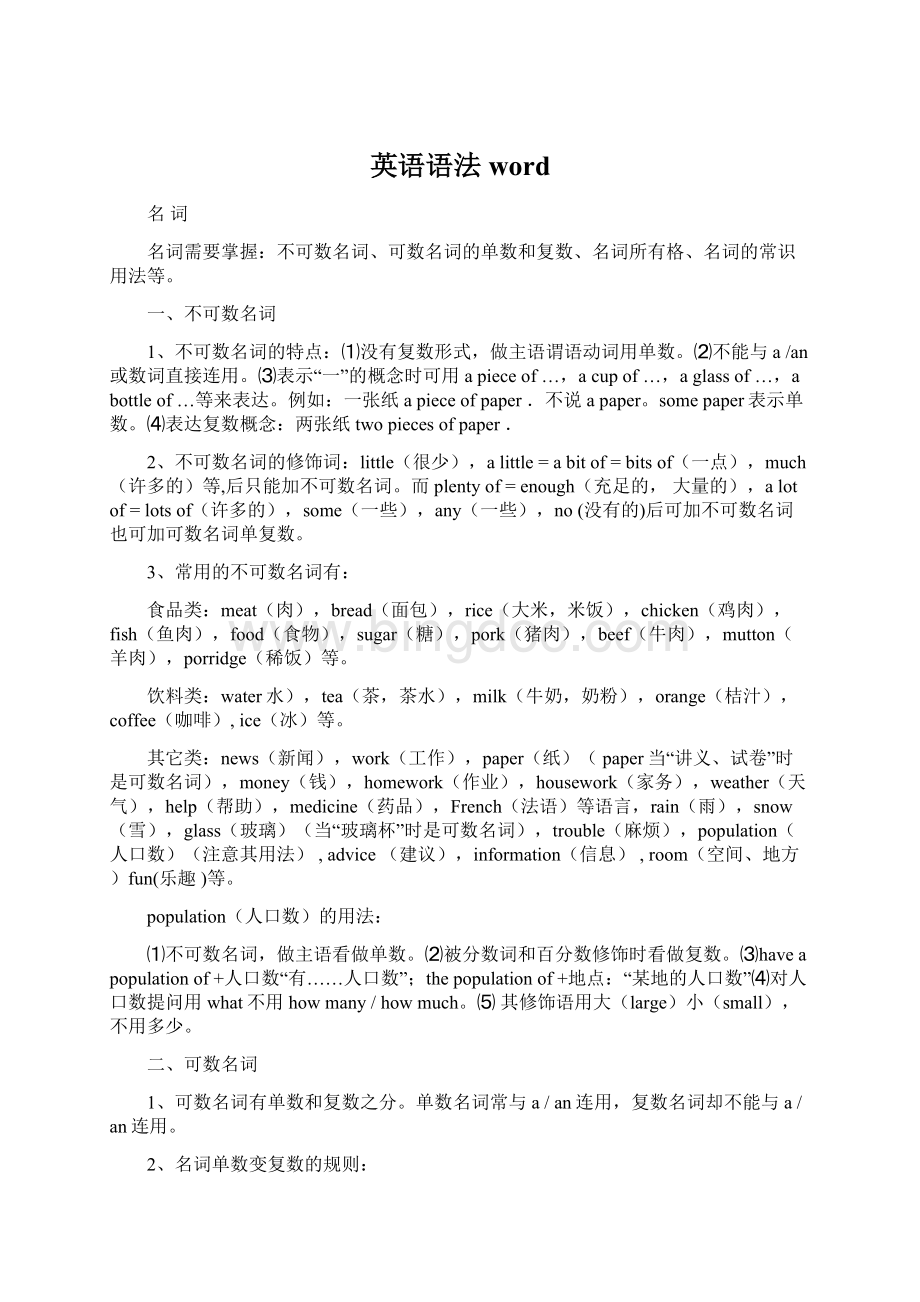英语语法word.docx
《英语语法word.docx》由会员分享,可在线阅读,更多相关《英语语法word.docx(115页珍藏版)》请在冰点文库上搜索。

英语语法word
名词
名词需要掌握:
不可数名词、可数名词的单数和复数、名词所有格、名词的常识用法等。
一、不可数名词
1、不可数名词的特点:
⑴没有复数形式,做主语谓语动词用单数。
⑵不能与a/an或数词直接连用。
⑶表示“一”的概念时可用apieceof…,acupof…,aglassof…,abottleof…等来表达。
例如:
一张纸apieceofpaper.不说apaper。
somepaper表示单数。
⑷表达复数概念:
两张纸twopiecesofpaper.
2、不可数名词的修饰词:
little(很少),alittle=abitof=bitsof(一点),much(许多的)等,后只能加不可数名词。
而plentyof=enough(充足的,大量的),alotof=lotsof(许多的),some(一些),any(一些),no(没有的)后可加不可数名词也可加可数名词单复数。
3、常用的不可数名词有:
食品类:
meat(肉),bread(面包),rice(大米,米饭),chicken(鸡肉),fish(鱼肉),food(食物),sugar(糖),pork(猪肉),beef(牛肉),mutton(羊肉),porridge(稀饭)等。
饮料类:
water水),tea(茶,茶水),milk(牛奶,奶粉),orange(桔汁),coffee(咖啡),ice(冰)等。
其它类:
news(新闻),work(工作),paper(纸)(paper当“讲义、试卷”时是可数名词),money(钱),homework(作业),housework(家务),weather(天气),help(帮助),medicine(药品),French(法语)等语言,rain(雨),snow(雪),glass(玻璃)(当“玻璃杯”时是可数名词),trouble(麻烦),population(人口数)(注意其用法),advice(建议),information(信息),room(空间、地方)fun(乐趣)等。
population(人口数)的用法:
⑴不可数名词,做主语看做单数。
⑵被分数词和百分数修饰时看做复数。
⑶haveapopulationof+人口数“有……人口数”;thepopulationof+地点:
“某地的人口数”⑷对人口数提问用what不用howmany/howmuch。
⑸其修饰语用大(large)小(small),不用多少。
二、可数名词
1、可数名词有单数和复数之分。
单数名词常与a/an连用,复数名词却不能与a/an连用。
2、名词单数变复数的规则:
一般情况加-s。
以s,x,ch,sh结尾的加-es。
以“辅音字母+y”结尾的,变y为i,再加-es。
但以“元音字母+y”结尾的直接加-s
以“f(e)”结尾的,把f(e)变成v,再加-es。
以“o”结尾的:
多数加-s,(但tomato---tomatoes,potato--potatoes,hero--heroes)。
特殊情况:
(1)foot----feet,tooth-----teeth
(2)变a为e:
man,woman,policeman,Frenchman,Frenchwoman,Englishwoman,Englishman(但German----Germans)(3)单复数相同:
people,sheep,Chinese,Japanese,deer(4)child-----children,mouse----mice,fish---fish/fishes(5)由man或woman修饰的名词变复数须都变。
例如:
amanteacher-----menteachers,awomandoctor-----womendoctors。
但其余的名词修饰时却不变。
如aboystudent--boystudents
4、可数名词复数的修饰词:
few(很少),afew(几个),many(许多的),anumberof(大量的),several(几个)等后必须加名词复数。
注意:
few表示否定意思,afew表示肯定意思。
no,any,enough,plentyof,alotof=lotsof,some(见上)
三、注意区别:
little/alittle/few/afew:
①little/alittle+不可数名词;few/afew+名词复数。
②little/few表示否定意思;alittle/afew表示肯定意思。
③vey+few/little,only/quite/just+afew/alittle。
④注意:
alittle=asmall“小的”。
⑤alittle/abit的区别:
1.alittle=abit,后+形容词或副词比较级或原级(tired/hungry/thirsty)
2.abitof=alittle,后+不可数名词3.notabit“一点也不”;notalittle“非常”。
no/some/any的用法:
①some“一些”,用于肯定句,也可用于表示请求(Would/Could/Willyou…?
),提建议(Shallwe…?
/Whynot…?
/Whatabout…?
/Howabout…?
)和反问句的问句中;“某一个”,后加名词单数。
②any“一些”,用于否定句和问句中;“任何的”,用于肯定句、条件句中,三者或以上,后加名词单数;“稍微”,用于比较级前。
③no“没有”,作定语修饰名词;no+名词单数=nota/an+名词单数;no+名词复数/不可数名词=notany+名词复数/不可数名词。
many/much/alotof:
①“许多的”。
many+名词复数;much+不可数名词;alotof+名复数/不可数名词
②toomuch+不可数名词toomany+名词复数muchtoo+形容词/副词
howmuch+不可数名词howmany+名词复数
anumberof/thenumberof
anumberof“许多的”,后加名词复数,做主语看做复数;thenumberof+名词:
“……的数量”,做主语看做单数。
三、名词所有格
名词所有格有三种表达法:
表示人或时间时用's:
当词尾无s时加's;当词尾有s时只加’。
注意区别:
JimandKate's+名词单数或复数(共同拥有);Jim'sandKate's+名词复数(各自拥有)。
表示物时用of表达所有关系,注意与汉语的语序不同。
双重所有格:
afriendofTom's等。
注意:
afriendofmine/his/hers/ours/yours/theirs(用名词性物主代词)。
注意以下表达:
①thewaytothepark,thekeytothedoor,theanswertothequestion,thebridgetoknowledge,theentranceto…
②在表示某人的家、办公室、店铺等,所有格后的名词省略:
atthedoctor's,atUncleWang's,attheGreen's/atMrGreen's等。
③区别five-year-old(“5岁的”,做形容词修饰名词)与fiveyearsold(“5岁”,不能修饰名词,只能做表语)的用法。
人称代词
包括主格和宾格。
主格用于句首或动词前作主语;宾格用于动词或介词后作宾语。
主格:
I,you,he,she,it,we,you,they。
宾格:
me,you,him,her,it,us,you,them。
注意:
在并列主语中,人称的排列顺序:
1一般情况或接受表扬(单):
you--he/she/it--I,(复)we--you--they
2②接受批评:
(单)I--he/she/it--you。
物主代词
包括形容词性和名词性。
形容词性后必须加名词,不能单独使用;名词性相当于名词,单独使用,后不能再加名词。
形容词性:
my,your,his,her,its,our,your,their。
名词性:
mine,yours,his,hers,its,ours,yours,theirs。
注意:
her既是宾格,又是形容词性。
his既是形容词性又是名词性。
反身代词
反身代词有:
myself,yourself,himself,herself,itself,ourselves,yourselves,themselves。
常用的反身代词的结构:
①teachoneself=learn…byoneself(自学)②helponeselfto…(随便吃……)
③byoneself=alone(独自)④enjoyoneself=haveagoodtime(过得很愉快)
⑤hurtoneself(伤了自己)⑥dressoneself(自己穿衣服)
⑦makeoneself…(使自己……)⑧thinkofoneself(为自己着想)
冠词
冠词分定冠词the和不定冠词a/an。
其用法如下:
一、不定冠词的用法:
1、a:
用于辅音音标前;也可说用于辅音字母前(但f,h,l,m,n,r,s,x,hour,honest前却用an)。
2、an:
用于元音音标前;也可说用于元音字母前(但u,useful,used,one前却用a)。
二、定冠词the在辅音前读[T[],在元音前读[TI:
]。
其用法如下:
1、用the的情况:
①特指某人或某物。
②双方都熟悉的人或物。
③上文已提到的人或物,下文再提到。
④世界上独一无二的事物前。
⑤形容词的最高级前;序数词前。
⑥与same一起连用。
⑦姓的复数前加the,表示一家人或夫妻2人,做主语谓语动词用复数;姓的所有格前加the,表示某人家。
⑧乐器前(playthepiano/violin)。
⑨the+形容词:
表示一类人(theyoung/old/dead/poor/rich),做主语谓语动词用复数。
⑩由普通名词构成的专有名词前(theYellowRiver)。
2、不用the的情况:
①专有名词前。
②节日、球类运动名称、三餐、季节、月份、星期、语种、颜色、学科等。
③名词前有this,that,these,those,some及物主代词修饰时。
④复数名词表示一类。
Horsesareusefulanimals.
数词
数词分基数词、序数词、分数词等。
一、基数词
1--12的拼写形式。
(one,two,three,four,five,six,seven,eight,nine,ten,eleven,twelve)。
13--19:
--teen(thirteen,fourteen,fifteen,sixteen,seventeen,eighteen,nineteen)。
“几十”:
--ty(twenty,thirty,forty,fifty,sixty,seventy,eighty,ninety)。
“几十几”:
先说“几十”,再说“几”,中间加连字号“-”。
如:
thirty-four。
“几百几十几”:
先说“几百”,再加“and”,再说“几十几”。
如:
twohundredandtwenty-two。
1000以上的数:
从后往前数,每三位数为一组前加一个“,”。
第一个“,”读thousand,第二个读million,第三个读billion。
注意:
hundred,thousand,million,billion前有具体数字,后不加s,也不加“of”;前无具体数字,后加“s”并加“of”。
如:
hundredsof(数以百计的),thousandsof(数以千计的),millionsof(数以百万计的),billionsof(数以十亿计的)。
但注意several/many/afew/some+hundred/hundredsof的用法.另外注意:
twohundredofthestudentsinourschool的意思。
序数词
序数词表示事物的顺序,其前要加定冠词the,有时其前加不定冠词a/an,表示“再一”、“又一”的意思。
基数词变序数词的规则:
①1--3:
拼写独特(one--first,two--second,three--third)。
②4--19:
基数词+th(注意:
five--fifth,eight--eighth,nine--ninth,twelve--twelfth)。
③“几十”:
变y为i再加-eth。
如:
twenty---twentieth。
④“几十几”:
十位数不变,只变个位数为序数词。
如:
thirty-five——thirty-fifth。
注意:
序数词可缩写:
阿拉伯数字+序数词最后二个字母,如:
1st,2nd,3rd,4th,21st,52nd,43rd。
分数词
分数词由基数词和序数词构成,其结构:
“分子--分母”。
分子用基数词,分母用序数词。
当分子大于1时,分母的序数词后要加“s”。
如:
1.1/2:
one--second或ahalf。
2.1/4:
one-fourth或aquarter。
3.3/4:
three-fourths或threequarters。
4.1.5小时:
oneandahalfhours=an/onehourandahalf。
四、数词的应用:
ClassOne=thefirstclass,LessonOne=thefirstlesson,Room30
5月1日:
May.1或Maythefirst或thefirstofMay。
100metres与100--metre的区别。
时刻的表达:
①5:
00----five(o'clock)。
②5:
15----fivefifteen或fifteenpastfive或aquarterpastfive(分钟+past+小时)。
③5:
30----fivethirty或halfpastfive。
④5:
45--fiveforty-five或fifteentosix或aquartertosix:
(60-分钟)+to+(小时+1)
数学运算公式:
①加法:
Fiveplus/andfourisnine。
②减法:
Tenminussixisfour。
③乘法:
Twotimesfiveisten。
或Twomultipliedbyfiveisten。
④除法:
Fifteendividedbyfiveisthree。
不定代词
(一)、all/none/both/either/neither
both:
①“(二者)都”。
与not连用表示半否定。
②位于系动词are、情态动词、助动词后,行为动词前。
③常用的句型结构:
bothof…/both…and…/both+名词复数,作主语时,谓语动词用复数。
either:
①“(二者)任何一个”。
②常用结构:
eitherof…/either+名词单数,作主语时,谓语动词用单数;either…or…做主语时,谓语动词根据就近原则。
③当“也”时,用于否定句句末,区别于too/aswell(用于肯定句句末)/also(句中,位于系动词、情态动词、助动词后,行为动词前)。
neither:
①“(二者)都不”,否定词,与both相反。
②常用结构:
neitherof…,neither+名词单数,做主语时,谓语动词用单数;neither…nor…,与both…and…相反,做主语时,谓语动词根据就近原则。
③也可引导倒装句,表示“也不”。
其结构:
“否定句,neither/nor+助动词+主语。
”与“肯定句,so+助动词+主语。
”区别。
all:
①“(三者或以上)都”。
与not连用表示半否定。
②位置同both。
③常用结构:
allof…,all+名词复数,做主语,谓语动词用复数。
none:
①“(三者或以上)没有一个”,与all相反。
②常用结构:
noneof…做主语,谓语动词可单可复。
③否定词,常用来回答由Howmany/Howmuch引导的疑问句。
练习:
选择填空。
1.Therearemanynewbuildingson_____sideoftheroad.A.eitherB.neitherC.bothD.all
2._____ofushasreadthestory,soweknownothingaboutit.A.SomeB.BothC.NoneD.All
3.Thefatherwishedthetwinstobedoctors,but_____ofthemlikedtostudymedicine.
A.bothB.neitherC.eitherD.none
4.--Whenshallwemeetagainnextweek?
--____dayisOK.A.EitherB.NeitherC.NoneD.Any
5.____ofthetwonewbooksareinteresting.A.AllB.BothC.AnyD.Either
6.LucyandIareclassmates.We_____inClassOne.A.allareB.areallC.bothareD.areboth
7.--WhichofthetwoEnglishdictionarywillyoubuy?
---I'llbuy_____ofthem.SoIcangiveonetomyfriendHelen.A.eitherB.neitherC.allD.both
8.--Whichwouldyoulike,riceornoodles?
--____isOK.I'mhungry.
A.EitherB.NeitherC.AllD.Both
9.Iaskedthetwinstocometomybirthdayparty.But___cameatlast.A.bothB.neitherC.allD.none
10.Therearemanytallgreentreeson_____sidesofthestreet.A.eitherB.bothC.allD.every
11.--Whichwouldyouliketodrink,coffeeororangejuice?
--_____,pleasegivemeacupoftea.A.NeitherB.BothC.AllD.None
12.--Whichdoyouprefer,abottleoforangeorabottleofmilk?
--_____,thanks.I'dlikeacupoftea.A.NeitherB.BothC.AllD.None
13.--Doyoulike_____ofthem?
--No.Idon'tlike_____ofthem.
A.both/bothB.either/eitherC.either/bothD.both/either
14.--Whatwouldyouliketohave,coffeeortea?
--_____.I'dliketohaveaglassofwater.
A.NeitherB.BothC.EitherD.Each
15.It'sreallyhardforLucyandLilytosolvethemathsproblem.Because_____ofthemisgoodatmaths.A.bothB.neitherC.allD.none
16.--Doyoulivebyyourself,MrWang?
--Yes.Ihavetwosons.But_____ofthemliveswithme.TheyarestudyinginAmerica.
A.bothB.neitherC.eitherD.none
17.--MayIuseyourpen?
--Yes.Herearetwoandyoucanuse____ofthem.
A.bothB.everyC.anyD.either
18.Wecouldn'tbuyanythingbecause_____oftheshopsopenedatthattime.
A.allB.someC.anyD.none
19.Thatplaceisn'tinterestingatall.____ofuswantstogothere.A.NeitherB.BothC.AllD.Some
20.--Whichsweaterdoyouprefer,theyellowoneortheredone?
---_____.Ilikealightblueone.A.EitherB.BothC.AnyD.Neither
21.Ifyoudon'twanttogoswimming,Iwon't,______.A.tooB.alsoC.